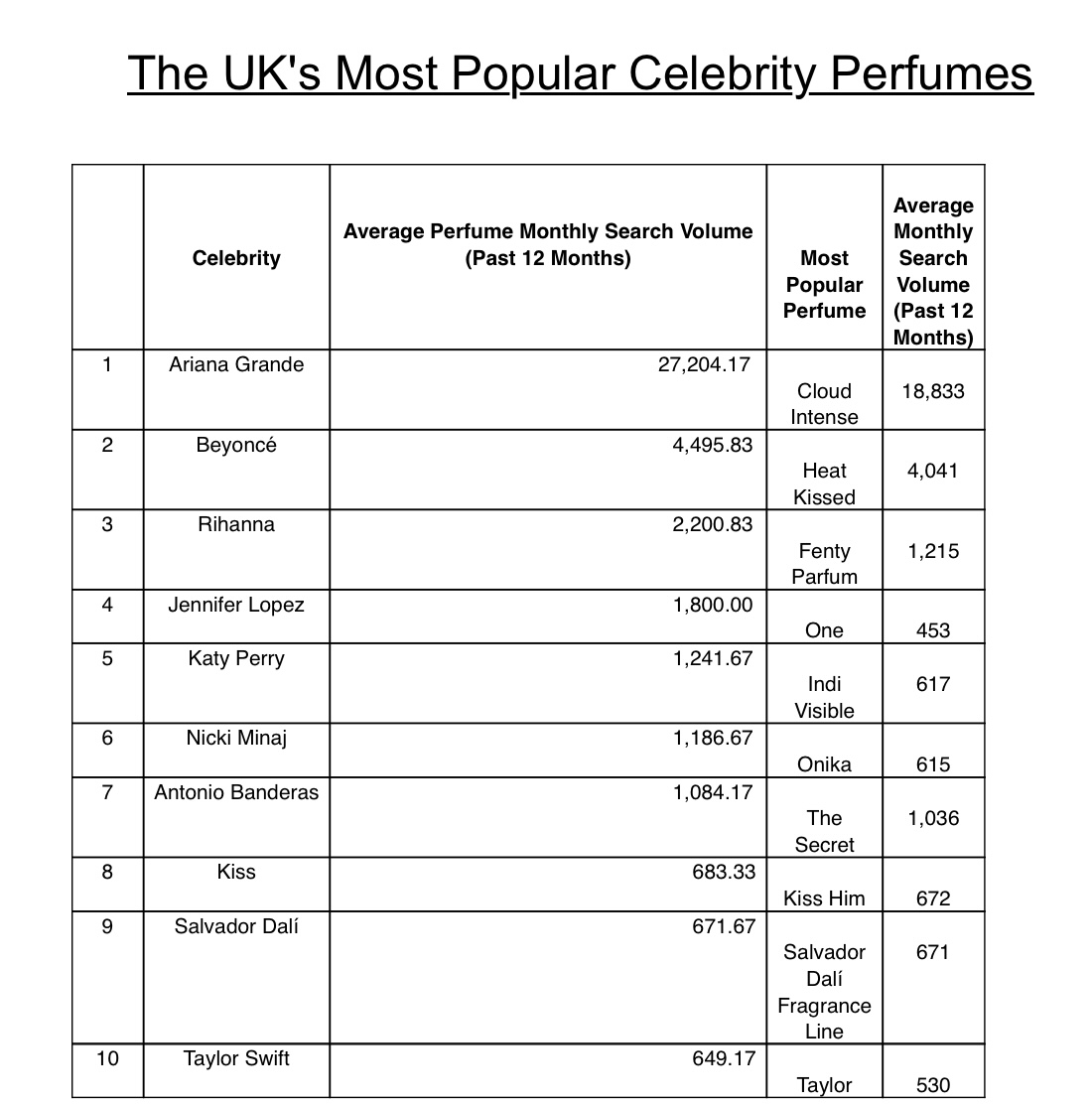Uncovering the UK’s most sought-after celebrity fragrances…

New research reveals Britain’s most popular celebrity perfumes, with Ariana Grande taking the top spot.
Research conducted by perfume samples specialists Parfumery, examined Google search data of every celebrity-produced perfume and how many searches they have received, on average, per month over the past year.
The data revealed that Ariana Grande has taken over the celebrity perfume world and is proving extremely popular. Searches for all of Ariana Grande’s perfumes receive an average of 27,204 searches per month overall with her most popular perfume Cloud Intense, averaging 18,883 searches per month.
Beyoncé is the UK’s second favourite celebrity producing perfumes, receiving an average of 4,495 searches per month. Beyoncé The most popular Beyoncé perfume is Heat Kissed, which receives an average of 4,041 searches per month in the UK.
Rihanna is the third most popular celebrity in the UK regarding perfume with searches for all of her scents receiving 2,200 searches per month, on average in the UK. Rihanna’s most popular perfume is Fenty Parfum which receives 1,215 searches per month. Other popular perfumes produced by Rihanna are Rouge Love, Crush and Kiss.
Britain’s fourth most popular celebrity is Jennifer Lopez, whose perfumes receive an average of 1,800 searches per month. Jennifer Lopez’s most popular perfume is One, which receives an average of 453 searches per month in the UK.
The fifth most favoured celebrity is Katy Perry, whose perfumes receive an average of 1,241 searches per month. Katy Perry has produced various scents over the past ten years, her most famous being Indi Visible which receives an average of 617 searches per month in the UK.
Nicki Minaj is the UK’s sixth most favoured celebrity to produce perfumes, with an average of 1,186 searches per month for all her perfumes. The most popular Nicki Minaj fragrance is Onika, which is searched for 615 times on average per month in the UK.
Antonio Banderas and the American rock band Kiss are the seventh and eighth most popular celebrities to bring out a fragrance. Antonio Banderas fragrances receive an average of 1,084 searches per month, and Kiss’s fragrances receive an average of 683. Antonio Banderas’ most popular fragrance is The Secret, which is searched 1,036 times on average per month in the UK, and Kiss’ most popular perfume in the UK is Kiss Him, with 672 searches.
The UK’s ninth most favoured celebrity is the popular and late Spanish artist Salvador Dalí, whose fragrance line receives an average of 671 searches per month in the UK. His first fragrance, Salvador Dalí, was released in 1983, and other popular scents in his line include Laguna, Salvador Dalí Pour Homme and Le Roy Soleil.
The tenth most popular celebrity in the rankings is Taylor Swift, who receives an average of 649 searches per month in the UK for her fragrances. Her most favoured and searched-for perfume, Taylor, receives an average of 530 searches per month in the UK.
An expert from Parfumery commented:
“Celebrities with large fanbases, such as Ariana Grande and Beyonce, are incredibly popular for bringing out merchandise and finding the best ways to connect with fans across the globe, and fragrances are one of the most connective and trendy ways to do so.
Brits have been extremely supportive of celebrity perfumes which seemed to skyrocket during the mid-noughties. As scent is such an intimate and personal part of our lives, many can be picky about which fragrances to choose from, which is another reason why Brits may be more inclined to purchase one made and worn by one of their favourite celebrities.”






